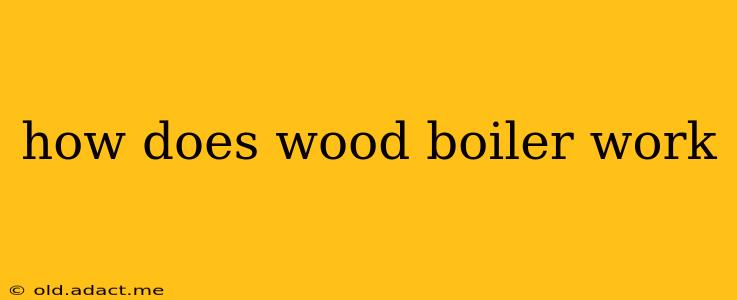How Does a Wood Boiler Work? A Comprehensive Guide
Wood boilers, a popular choice for heating homes and providing hot water, operate on a relatively simple yet efficient principle: burning wood to create heat. However, the process is more nuanced than it might initially seem. This guide delves into the mechanics, benefits, and considerations of using a wood boiler.
What are the main components of a wood boiler?
A wood boiler's core components work together to efficiently convert the chemical energy in wood into thermal energy. Key parts include:
- Firebox: This is where the wood is burned. Its design significantly impacts burn efficiency and emissions. Larger fireboxes allow for longer burn times, while well-designed fireboxes promote complete combustion, minimizing creosote buildup.
- Heat Exchanger: This is the heart of the system. Hot gases produced by combustion pass through the heat exchanger, transferring their heat to water circulating within the boiler. Different designs exist, including fire-tube (gases pass through tubes surrounded by water) and water-tube (water passes through tubes surrounded by hot gases) systems, each with its own efficiency and maintenance characteristics.
- Water Jacket: This surrounds the firebox and heat exchanger, containing the water that gets heated. The design and material of the water jacket are critical for efficient heat transfer and durability.
- Ash Pan: This collects the ash residue from the combustion process. Regular ash removal is essential for optimal performance and safety.
- Chimney/Stack: This vents the smoke and combustion gases safely to the outside. Proper chimney design and maintenance are crucial for preventing dangerous backdrafting and creosote fires.
- Controls (Thermostat, Blower): Modern wood boilers often include controls to automate the process, maintaining a desired water temperature and possibly managing air intake for efficient combustion.
How does the combustion process work in a wood boiler?
The combustion process in a wood boiler is a controlled chemical reaction. Here's a step-by-step breakdown:
- Wood Loading: Wood logs are loaded into the firebox.
- Ignition: The wood is ignited, typically using kindling and starter material.
- Combustion: The wood burns, releasing heat and producing hot gases (primarily carbon dioxide, water vapor, and other byproducts).
- Heat Transfer: These hot gases flow through the heat exchanger, transferring their thermal energy to the water within the boiler's water jacket.
- Heat Distribution: The heated water is then circulated throughout the heating system (radiators, underfloor heating, etc.) to provide warmth to the building.
- Exhaust: The remaining gases are exhausted safely through the chimney.
What are the different types of wood boilers?
Wood boilers are categorized in various ways, most commonly by their combustion method:
- Conventional Wood Boilers: These rely on simple combustion, often requiring frequent wood loading.
- High-Efficiency Wood Boilers: These employ advanced combustion techniques, such as secondary burn chambers, to extract more heat from the wood and produce fewer emissions.
- Gasification Wood Boilers: These use a more complex process that gasifies the wood before burning, resulting in higher efficiency and reduced emissions.
The choice of boiler type depends on factors like budget, heating needs, and environmental concerns.
What are the advantages and disadvantages of using a wood boiler?
Advantages:
- Renewable Fuel Source: Wood is a sustainable resource, particularly when sourced responsibly.
- Cost-Effective (potentially): Wood can be a cheaper fuel source than electricity or natural gas, depending on local wood prices and energy costs.
- Reduced Reliance on Fossil Fuels: Using a wood boiler reduces reliance on non-renewable energy sources.
Disadvantages:
- Labor Intensive: Requires regular wood handling and ash removal.
- Maintenance: Regular maintenance, including cleaning the firebox and chimney, is essential.
- Environmental Impact (if not managed correctly): Improperly managed wood burning can contribute to air pollution.
- Storage Space: Requires significant storage space for wood.
- Safety Concerns: Requires proper installation and operation to prevent fire hazards.
What safety precautions should I take when using a wood boiler?
Safety is paramount when operating a wood boiler. Key precautions include:
- Professional Installation: Always have your wood boiler installed by a qualified professional.
- Proper Chimney Maintenance: Regularly inspect and clean your chimney to prevent creosote buildup.
- Adequate Ventilation: Ensure proper ventilation in the boiler room to prevent carbon monoxide buildup.
- Fire Safety: Keep a fire extinguisher nearby and follow all fire safety guidelines.
- Regular Inspection: Regularly inspect the boiler for any signs of damage or malfunction.
This detailed guide provides a comprehensive overview of how a wood boiler works. Remember to consult with professionals for specific advice tailored to your needs and local regulations. Responsible wood boiler operation contributes to efficient heating and minimizes environmental impact.
